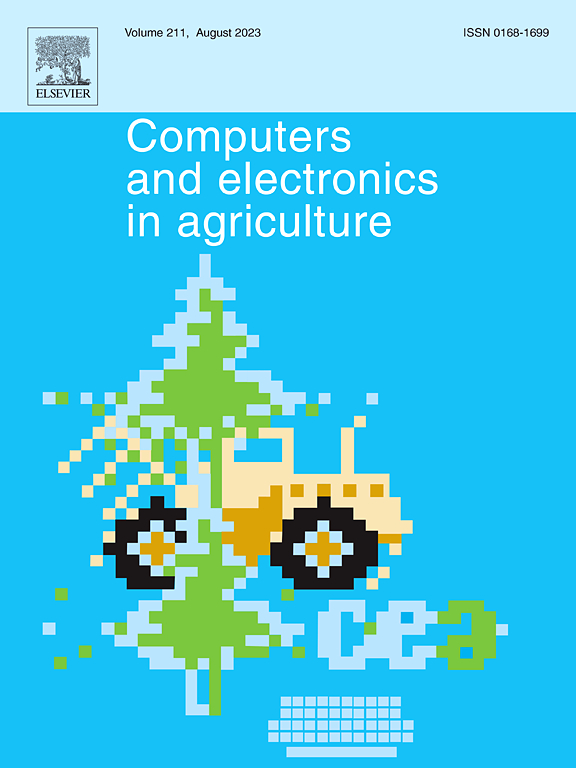An efficient posterior probability-based image fusion change detection model for the estimation of seasonal agricultural changes using microwave and optical datasets
IF 7.7
1区 农林科学
Q1 AGRICULTURE, MULTIDISCIPLINARY
引用次数: 0
Abstract
Detecting seasonal variations is an important application of remote sensing to understand temporal change patterns of agricultural land, soil productivity, and crop yield predictions. It also provides valuable insights for farmers and policymakers to make informed decisions. Remote sensing is one of the most effective and cost-efficient methods for monitoring agricultural land on a global scale. While optical sensors are commonly used to observe seasonal vegetation trends, their effectiveness is significantly limited by cloud cover and atmospheric disturbances. Whereas microwave sensors can penetrate the clouds and provide structural and moisture-related information, they lack spectral sensitivity to key vegetation indices derived from optical data. This article develops a novel posterior probability-based fusion change detection (PFCD) model by integrating the posterior probability space into image fusion and change detection, enabling the accurate estimation of seasonal agricultural changes. To validate the proposed model, a case study was conducted in a part of Punjab, India, for seasonal agricultural changes during the 2023–24 period, utilizing optical-based multispectral imager (MSI) from Sentinel-2 and microwave-based synthetic aperture radar (SAR) from Sentinel-1. The experiments confirmed that PFCD had achieved an accuracy of 92.73–96.41 %, with a kappa value of 0.89–0.95 for thematic maps and an accuracy of 90.21–93.05 %, with a kappa value of 0.89–0.93 for change maps. A cloud cover analysis further validated the model’s robustness, demonstrating its effectiveness in accurately estimating land surface changes during cloudy periods without compromising spectral or spatial detail.

一种基于后验概率的图像融合变化检测模型,用于微波和光学数据集的季节性农业变化估计
探测季节变化是遥感在了解农业用地、土壤生产力和作物产量预测的时间变化模式方面的重要应用。它还为农民和决策者做出明智的决策提供了宝贵的见解。遥感是在全球范围内监测农业用地最有效和最具成本效益的方法之一。虽然光学传感器通常用于观测季节性植被趋势,但其有效性受到云量和大气扰动的严重限制。虽然微波传感器可以穿透云层并提供结构和湿度相关信息,但它们对来自光学数据的关键植被指数缺乏光谱灵敏度。本文提出了一种基于后验概率的融合变化检测(PFCD)模型,将后验概率空间整合到图像融合和变化检测中,实现了对季节性农业变化的准确估计。为了验证所提出的模型,利用Sentinel-2的基于光学的多光谱成像仪(MSI)和Sentinel-1的基于微波的合成孔径雷达(SAR),在印度旁遮普省的部分地区进行了2023-24年期间的季节性农业变化的案例研究。实验结果表明,PFCD的准确率为92.73 ~ 96.41%,其中专题图的kappa值为0.89 ~ 0.95,变化图的kappa值为90.21 ~ 93.05%,变化图的kappa值为0.89 ~ 0.93。云覆盖分析进一步验证了该模型的鲁棒性,证明了它在不影响光谱或空间细节的情况下准确估计多云期间陆地表面变化的有效性。
本文章由计算机程序翻译,如有差异,请以英文原文为准。
求助全文
约1分钟内获得全文
求助全文
来源期刊

Computers and Electronics in Agriculture
工程技术-计算机:跨学科应用
CiteScore
15.30
自引率
14.50%
发文量
800
审稿时长
62 days
期刊介绍:
Computers and Electronics in Agriculture provides international coverage of advancements in computer hardware, software, electronic instrumentation, and control systems applied to agricultural challenges. Encompassing agronomy, horticulture, forestry, aquaculture, and animal farming, the journal publishes original papers, reviews, and applications notes. It explores the use of computers and electronics in plant or animal agricultural production, covering topics like agricultural soils, water, pests, controlled environments, and waste. The scope extends to on-farm post-harvest operations and relevant technologies, including artificial intelligence, sensors, machine vision, robotics, networking, and simulation modeling. Its companion journal, Smart Agricultural Technology, continues the focus on smart applications in production agriculture.
 求助内容:
求助内容: 应助结果提醒方式:
应助结果提醒方式:


